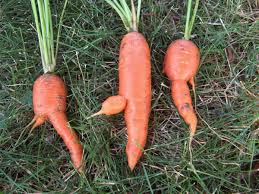 Two recent articles made me aware of a truer meaning of sustainable agriculture and where we need to go next in our farm-to-table awareness.
Two recent articles made me aware of a truer meaning of sustainable agriculture and where we need to go next in our farm-to-table awareness.
The first one was about the enormous waste in the EU (and likely in the US as well) created by discarding produce that doesn't look perfect even though it is in good condition and tastes just like its more conformist looking counterparts. A young Portuguese woman started a produce cooperative named Fruta Feia or Ugly Fruit to market and sell such imperfect produce at 20%-30% less.
The other article was from chef Dan Barber on widening the premise of sustainable agriculture and including in our food choices also those crops that are typically used as cover crops to replenish the soil. Soybeans, kidney beans or cowpeas (used as animal feed) are typical nitrogen replenishers for the soil. But Barber was talking about a much more sophisticated and complex crop rotation that is needed to keep the soil fertile and full of minerals, which guarantees not only superior taste but also mineral and trace element rich foods (less supplements you'll need to take). Such other crops might include rye, barley, or buckwheat, all little used in this country because less marketed and less known.
Sustainability, in agriculture and elsewhere, is about a wasteless circular process, in which all "waste" becomes a reusable base component for the next process in the circle, thereby eliminating the idea of "waste" altogether. A sustainable farm would not buy outside fertilizer, seeds, and pest management products, instead using the farm animal manure for fertilizer, using crop rotation, crop variety and inter-planting as main pest control techniques, and saving its seeds from one year to the next. Being able to sell its cover crops in addition to its "main crops" makes the farm more viable and eliminates further waste.
The whole idea behind truly sustainable agriculture is to embrace every part of the agricultural process, the whole kit and caboodle, whether it's the little used rye (here in the US at least), the funny looking strawberries, the carrots with a nose or legs, or the lesser known fava beans (I made a fava bean hummus the other day that was as delicious and tasty as a chickpea hummus).


